Taxation Law Assignment: FBT, CGT Calculations and Tax Planning
VerifiedAdded on 2023/03/30
|9
|2091
|352
Homework Assignment
AI Summary
This taxation law assignment addresses two key areas: Fringe Benefits Tax (FBT) and Capital Gains Tax (CGT). Question 1 focuses on XYZ Pty Ltd's FBT liability for a car fringe benefit provided to an employee, Devika, calculating depreciation, interest, operating costs, and taxable value using both statutory and cost basis methods to minimize FBT. The conclusion highlights the chosen method and resulting FBT liability. Question 2 examines the CGT implications for David, considering the sale of various assets. The analysis covers the liquidation of a house, a painting, a luxury yacht, and shares, determining CGT consequences, applying relevant exemptions, and utilizing the discount method. It also discusses how capital losses are treated. The assignment provides detailed calculations and explanations of relevant tax laws, including the application of the Income Tax Assessment Act 1997 (ITAA 1997) and the Fringe Benefits Tax Assessment Act 1986 (FBTAA 1986).
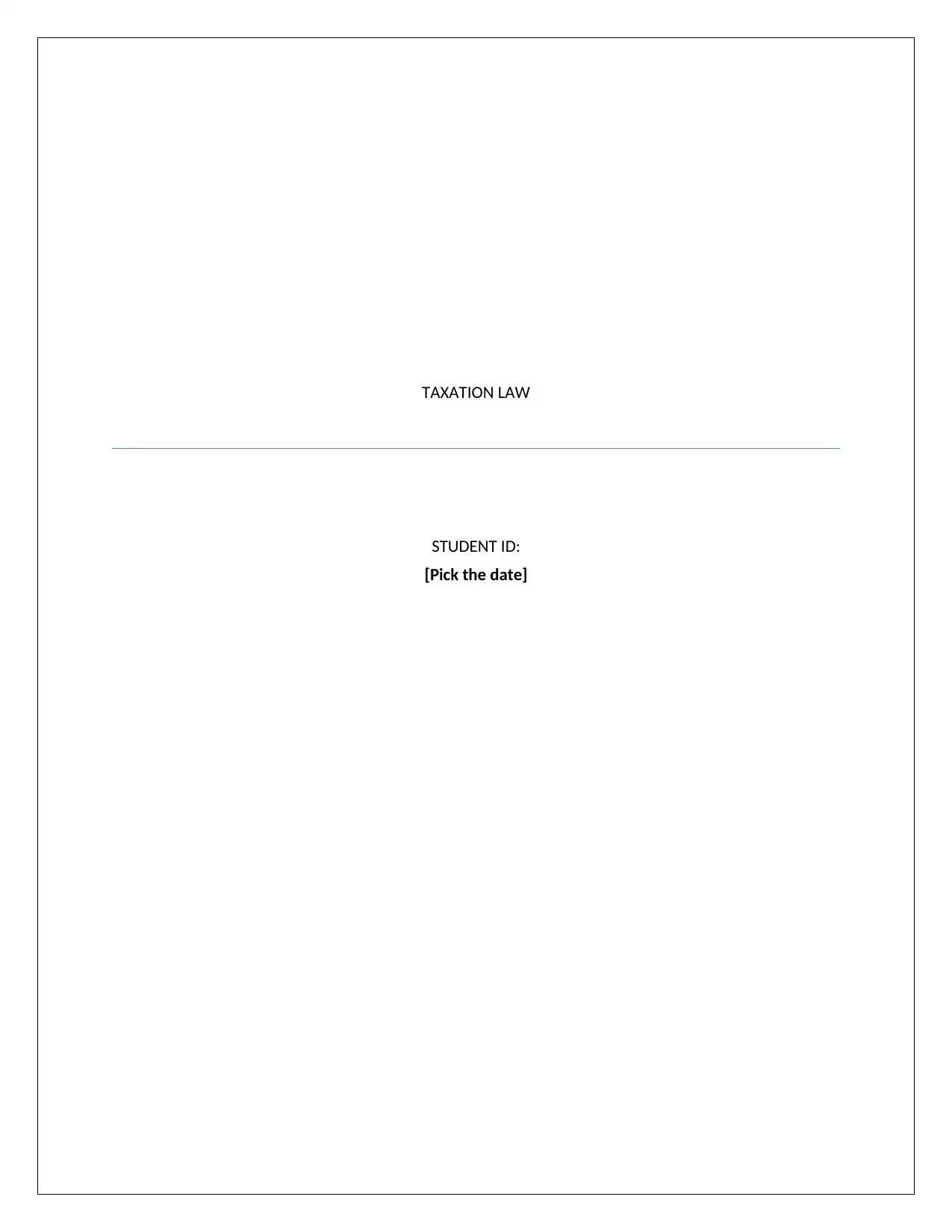
TAXATION LAW
STUDENT ID:
[Pick the date]
STUDENT ID:
[Pick the date]
Paraphrase This Document
Need a fresh take? Get an instant paraphrase of this document with our AI Paraphraser
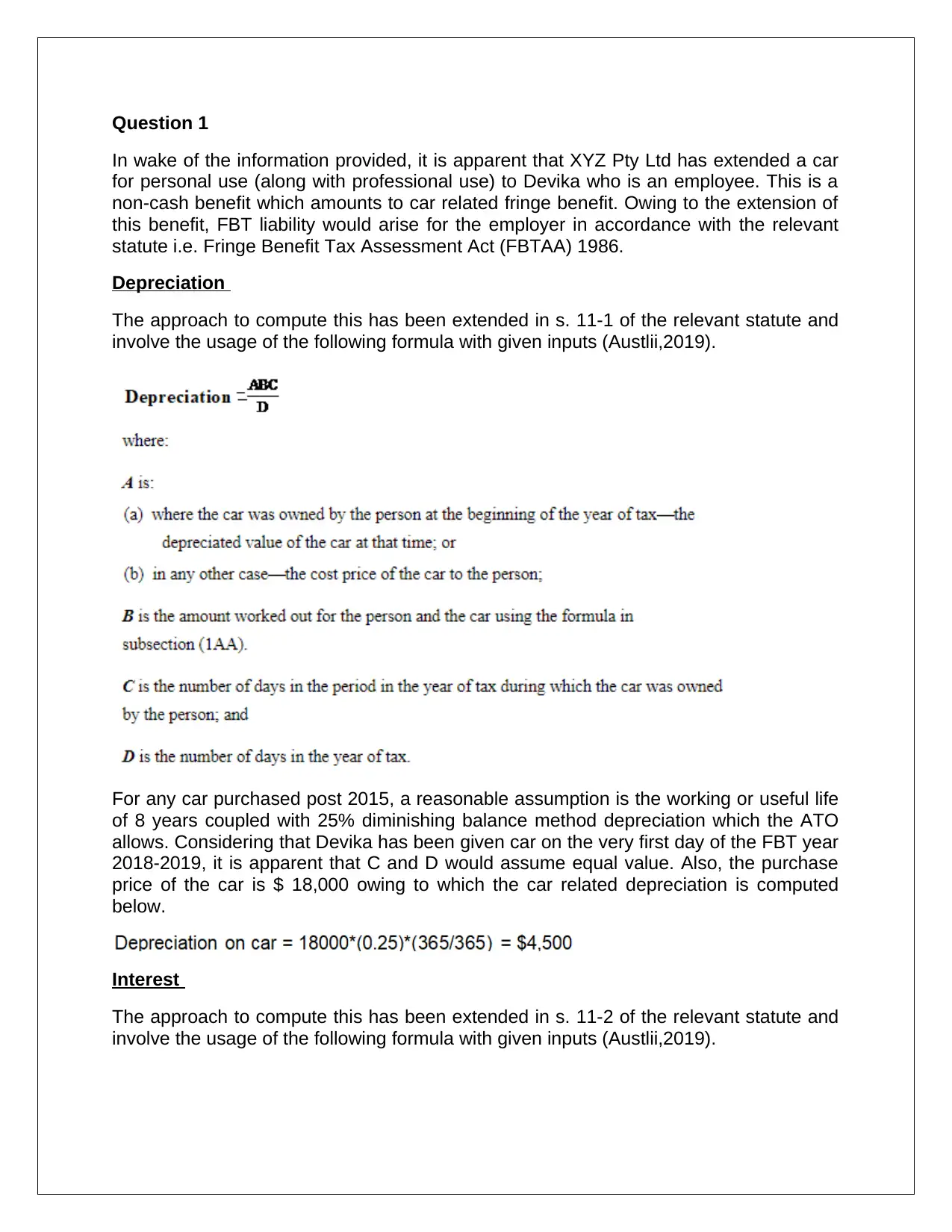
Question 1
In wake of the information provided, it is apparent that XYZ Pty Ltd has extended a car
for personal use (along with professional use) to Devika who is an employee. This is a
non-cash benefit which amounts to car related fringe benefit. Owing to the extension of
this benefit, FBT liability would arise for the employer in accordance with the relevant
statute i.e. Fringe Benefit Tax Assessment Act (FBTAA) 1986.
Depreciation
The approach to compute this has been extended in s. 11-1 of the relevant statute and
involve the usage of the following formula with given inputs (Austlii,2019).
For any car purchased post 2015, a reasonable assumption is the working or useful life
of 8 years coupled with 25% diminishing balance method depreciation which the ATO
allows. Considering that Devika has been given car on the very first day of the FBT year
2018-2019, it is apparent that C and D would assume equal value. Also, the purchase
price of the car is $ 18,000 owing to which the car related depreciation is computed
below.
Interest
The approach to compute this has been extended in s. 11-2 of the relevant statute and
involve the usage of the following formula with given inputs (Austlii,2019).
In wake of the information provided, it is apparent that XYZ Pty Ltd has extended a car
for personal use (along with professional use) to Devika who is an employee. This is a
non-cash benefit which amounts to car related fringe benefit. Owing to the extension of
this benefit, FBT liability would arise for the employer in accordance with the relevant
statute i.e. Fringe Benefit Tax Assessment Act (FBTAA) 1986.
Depreciation
The approach to compute this has been extended in s. 11-1 of the relevant statute and
involve the usage of the following formula with given inputs (Austlii,2019).
For any car purchased post 2015, a reasonable assumption is the working or useful life
of 8 years coupled with 25% diminishing balance method depreciation which the ATO
allows. Considering that Devika has been given car on the very first day of the FBT year
2018-2019, it is apparent that C and D would assume equal value. Also, the purchase
price of the car is $ 18,000 owing to which the car related depreciation is computed
below.
Interest
The approach to compute this has been extended in s. 11-2 of the relevant statute and
involve the usage of the following formula with given inputs (Austlii,2019).
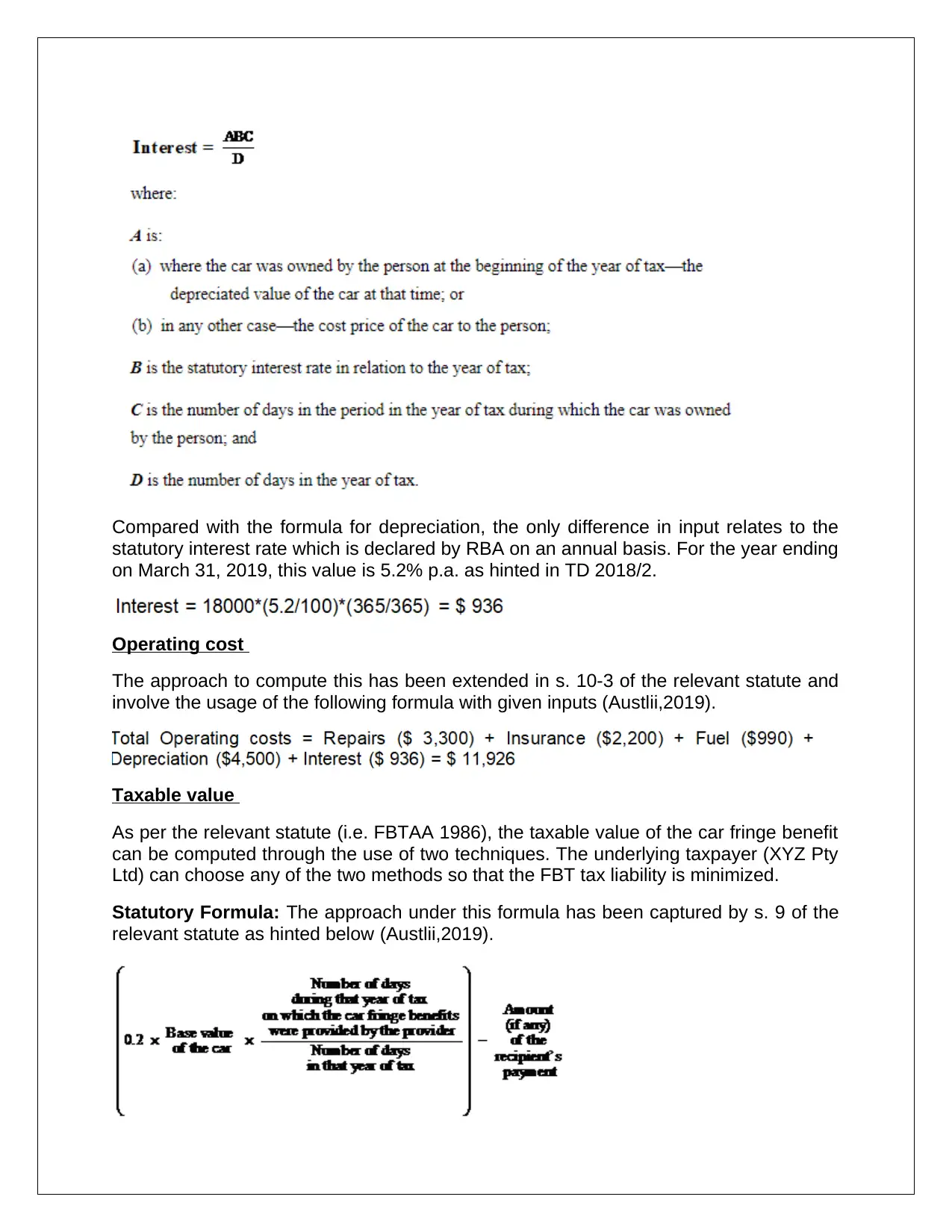
Compared with the formula for depreciation, the only difference in input relates to the
statutory interest rate which is declared by RBA on an annual basis. For the year ending
on March 31, 2019, this value is 5.2% p.a. as hinted in TD 2018/2.
Operating cost
The approach to compute this has been extended in s. 10-3 of the relevant statute and
involve the usage of the following formula with given inputs (Austlii,2019).
Taxable value
As per the relevant statute (i.e. FBTAA 1986), the taxable value of the car fringe benefit
can be computed through the use of two techniques. The underlying taxpayer (XYZ Pty
Ltd) can choose any of the two methods so that the FBT tax liability is minimized.
Statutory Formula: The approach under this formula has been captured by s. 9 of the
relevant statute as hinted below (Austlii,2019).
statutory interest rate which is declared by RBA on an annual basis. For the year ending
on March 31, 2019, this value is 5.2% p.a. as hinted in TD 2018/2.
Operating cost
The approach to compute this has been extended in s. 10-3 of the relevant statute and
involve the usage of the following formula with given inputs (Austlii,2019).
Taxable value
As per the relevant statute (i.e. FBTAA 1986), the taxable value of the car fringe benefit
can be computed through the use of two techniques. The underlying taxpayer (XYZ Pty
Ltd) can choose any of the two methods so that the FBT tax liability is minimized.
Statutory Formula: The approach under this formula has been captured by s. 9 of the
relevant statute as hinted below (Austlii,2019).
⊘ This is a preview!⊘
Do you want full access?
Subscribe today to unlock all pages.

Trusted by 1+ million students worldwide
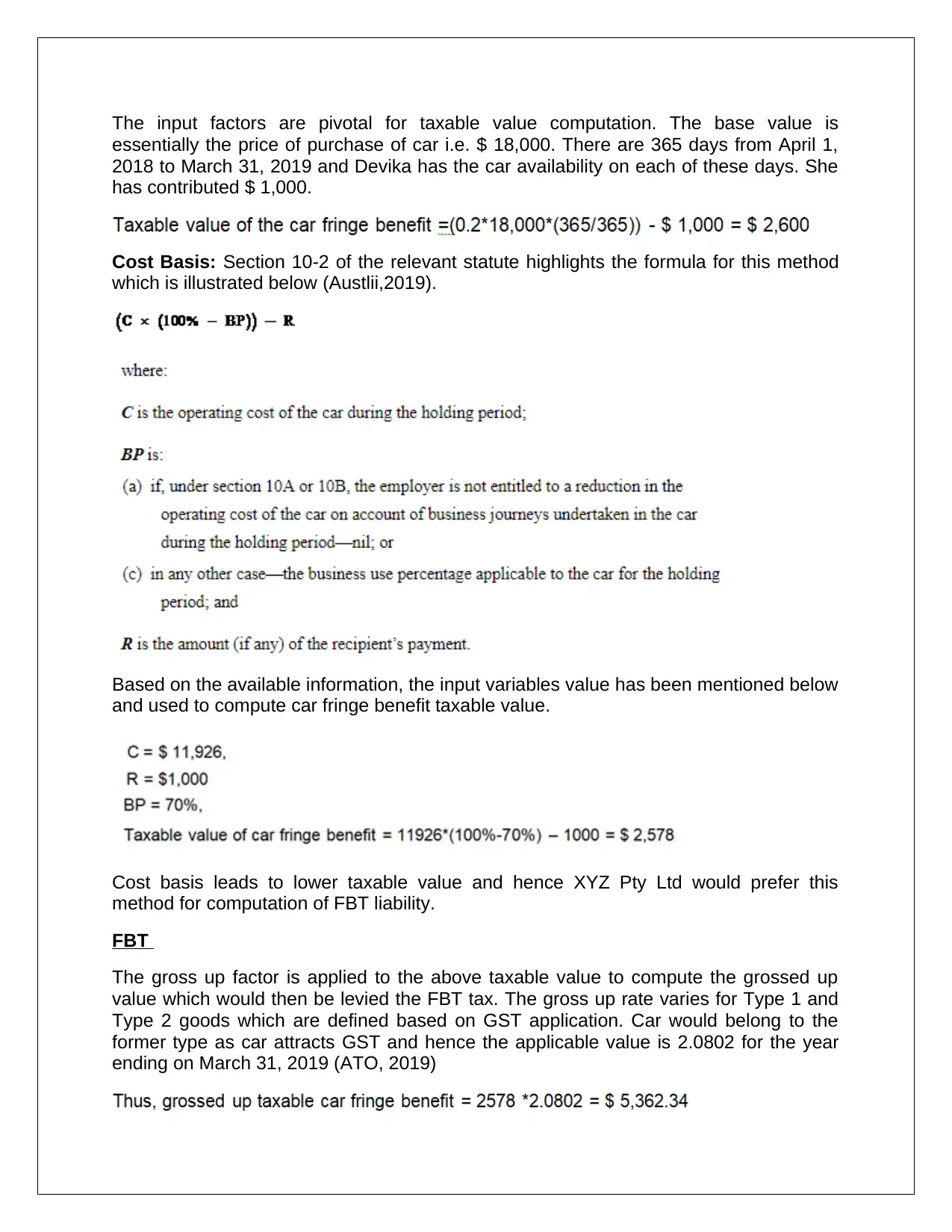
The input factors are pivotal for taxable value computation. The base value is
essentially the price of purchase of car i.e. $ 18,000. There are 365 days from April 1,
2018 to March 31, 2019 and Devika has the car availability on each of these days. She
has contributed $ 1,000.
Cost Basis: Section 10-2 of the relevant statute highlights the formula for this method
which is illustrated below (Austlii,2019).
Based on the available information, the input variables value has been mentioned below
and used to compute car fringe benefit taxable value.
Cost basis leads to lower taxable value and hence XYZ Pty Ltd would prefer this
method for computation of FBT liability.
FBT
The gross up factor is applied to the above taxable value to compute the grossed up
value which would then be levied the FBT tax. The gross up rate varies for Type 1 and
Type 2 goods which are defined based on GST application. Car would belong to the
former type as car attracts GST and hence the applicable value is 2.0802 for the year
ending on March 31, 2019 (ATO, 2019)
essentially the price of purchase of car i.e. $ 18,000. There are 365 days from April 1,
2018 to March 31, 2019 and Devika has the car availability on each of these days. She
has contributed $ 1,000.
Cost Basis: Section 10-2 of the relevant statute highlights the formula for this method
which is illustrated below (Austlii,2019).
Based on the available information, the input variables value has been mentioned below
and used to compute car fringe benefit taxable value.
Cost basis leads to lower taxable value and hence XYZ Pty Ltd would prefer this
method for computation of FBT liability.
FBT
The gross up factor is applied to the above taxable value to compute the grossed up
value which would then be levied the FBT tax. The gross up rate varies for Type 1 and
Type 2 goods which are defined based on GST application. Car would belong to the
former type as car attracts GST and hence the applicable value is 2.0802 for the year
ending on March 31, 2019 (ATO, 2019)
Paraphrase This Document
Need a fresh take? Get an instant paraphrase of this document with our AI Paraphraser
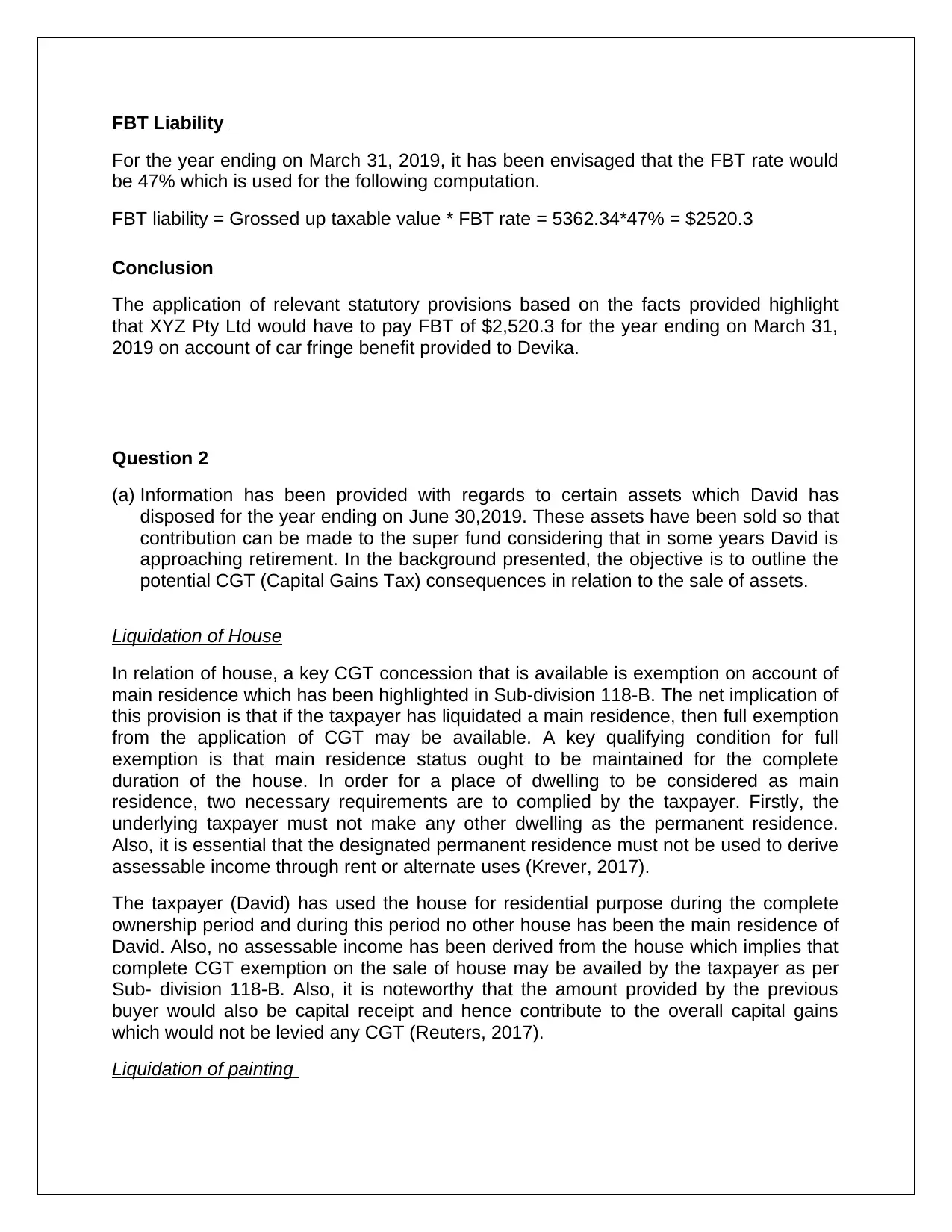
FBT Liability
For the year ending on March 31, 2019, it has been envisaged that the FBT rate would
be 47% which is used for the following computation.
FBT liability = Grossed up taxable value * FBT rate = 5362.34*47% = $2520.3
Conclusion
The application of relevant statutory provisions based on the facts provided highlight
that XYZ Pty Ltd would have to pay FBT of $2,520.3 for the year ending on March 31,
2019 on account of car fringe benefit provided to Devika.
Question 2
(a) Information has been provided with regards to certain assets which David has
disposed for the year ending on June 30,2019. These assets have been sold so that
contribution can be made to the super fund considering that in some years David is
approaching retirement. In the background presented, the objective is to outline the
potential CGT (Capital Gains Tax) consequences in relation to the sale of assets.
Liquidation of House
In relation of house, a key CGT concession that is available is exemption on account of
main residence which has been highlighted in Sub-division 118-B. The net implication of
this provision is that if the taxpayer has liquidated a main residence, then full exemption
from the application of CGT may be available. A key qualifying condition for full
exemption is that main residence status ought to be maintained for the complete
duration of the house. In order for a place of dwelling to be considered as main
residence, two necessary requirements are to complied by the taxpayer. Firstly, the
underlying taxpayer must not make any other dwelling as the permanent residence.
Also, it is essential that the designated permanent residence must not be used to derive
assessable income through rent or alternate uses (Krever, 2017).
The taxpayer (David) has used the house for residential purpose during the complete
ownership period and during this period no other house has been the main residence of
David. Also, no assessable income has been derived from the house which implies that
complete CGT exemption on the sale of house may be availed by the taxpayer as per
Sub- division 118-B. Also, it is noteworthy that the amount provided by the previous
buyer would also be capital receipt and hence contribute to the overall capital gains
which would not be levied any CGT (Reuters, 2017).
Liquidation of painting
For the year ending on March 31, 2019, it has been envisaged that the FBT rate would
be 47% which is used for the following computation.
FBT liability = Grossed up taxable value * FBT rate = 5362.34*47% = $2520.3
Conclusion
The application of relevant statutory provisions based on the facts provided highlight
that XYZ Pty Ltd would have to pay FBT of $2,520.3 for the year ending on March 31,
2019 on account of car fringe benefit provided to Devika.
Question 2
(a) Information has been provided with regards to certain assets which David has
disposed for the year ending on June 30,2019. These assets have been sold so that
contribution can be made to the super fund considering that in some years David is
approaching retirement. In the background presented, the objective is to outline the
potential CGT (Capital Gains Tax) consequences in relation to the sale of assets.
Liquidation of House
In relation of house, a key CGT concession that is available is exemption on account of
main residence which has been highlighted in Sub-division 118-B. The net implication of
this provision is that if the taxpayer has liquidated a main residence, then full exemption
from the application of CGT may be available. A key qualifying condition for full
exemption is that main residence status ought to be maintained for the complete
duration of the house. In order for a place of dwelling to be considered as main
residence, two necessary requirements are to complied by the taxpayer. Firstly, the
underlying taxpayer must not make any other dwelling as the permanent residence.
Also, it is essential that the designated permanent residence must not be used to derive
assessable income through rent or alternate uses (Krever, 2017).
The taxpayer (David) has used the house for residential purpose during the complete
ownership period and during this period no other house has been the main residence of
David. Also, no assessable income has been derived from the house which implies that
complete CGT exemption on the sale of house may be availed by the taxpayer as per
Sub- division 118-B. Also, it is noteworthy that the amount provided by the previous
buyer would also be capital receipt and hence contribute to the overall capital gains
which would not be levied any CGT (Reuters, 2017).
Liquidation of painting
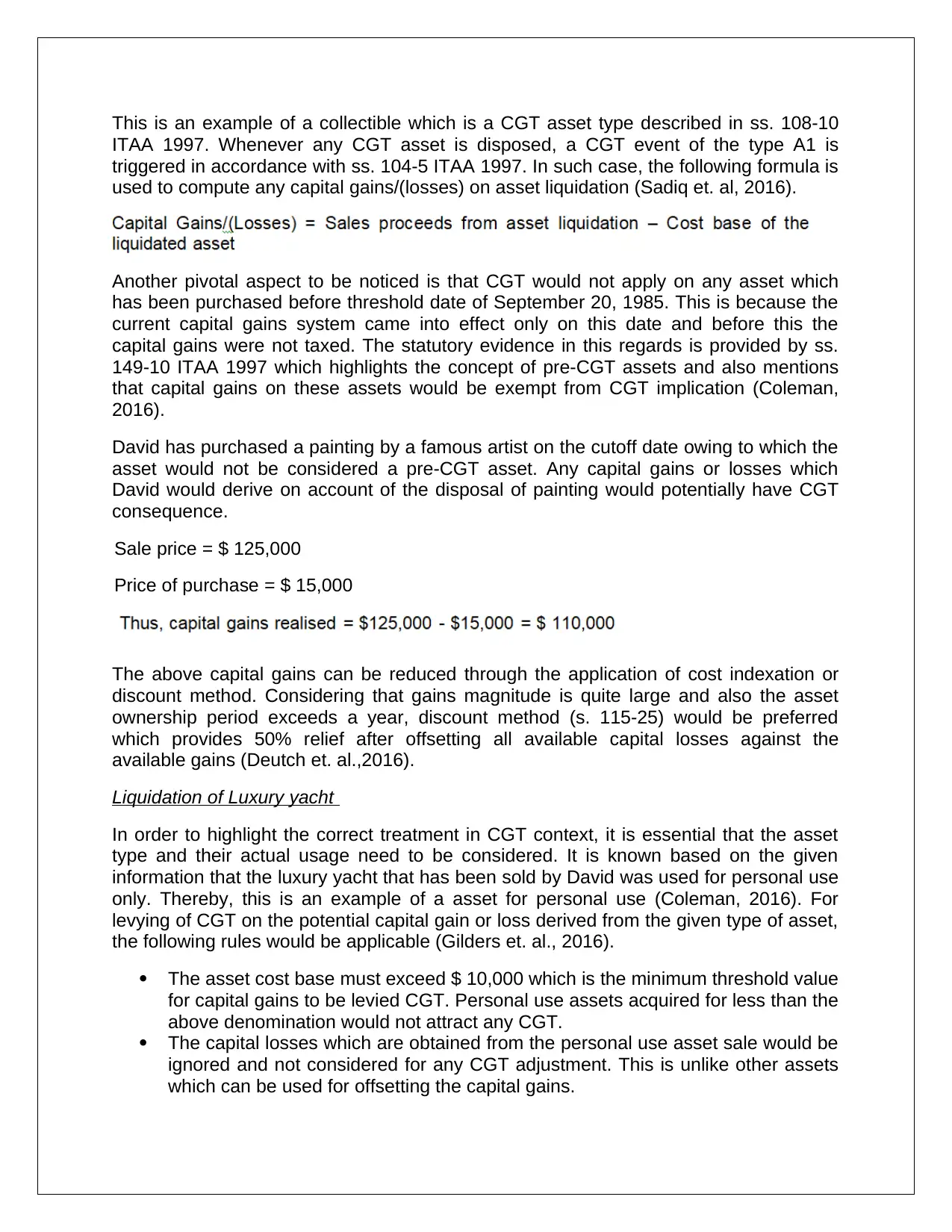
This is an example of a collectible which is a CGT asset type described in ss. 108-10
ITAA 1997. Whenever any CGT asset is disposed, a CGT event of the type A1 is
triggered in accordance with ss. 104-5 ITAA 1997. In such case, the following formula is
used to compute any capital gains/(losses) on asset liquidation (Sadiq et. al, 2016).
Another pivotal aspect to be noticed is that CGT would not apply on any asset which
has been purchased before threshold date of September 20, 1985. This is because the
current capital gains system came into effect only on this date and before this the
capital gains were not taxed. The statutory evidence in this regards is provided by ss.
149-10 ITAA 1997 which highlights the concept of pre-CGT assets and also mentions
that capital gains on these assets would be exempt from CGT implication (Coleman,
2016).
David has purchased a painting by a famous artist on the cutoff date owing to which the
asset would not be considered a pre-CGT asset. Any capital gains or losses which
David would derive on account of the disposal of painting would potentially have CGT
consequence.
Sale price = $ 125,000
Price of purchase = $ 15,000
The above capital gains can be reduced through the application of cost indexation or
discount method. Considering that gains magnitude is quite large and also the asset
ownership period exceeds a year, discount method (s. 115-25) would be preferred
which provides 50% relief after offsetting all available capital losses against the
available gains (Deutch et. al.,2016).
Liquidation of Luxury yacht
In order to highlight the correct treatment in CGT context, it is essential that the asset
type and their actual usage need to be considered. It is known based on the given
information that the luxury yacht that has been sold by David was used for personal use
only. Thereby, this is an example of a asset for personal use (Coleman, 2016). For
levying of CGT on the potential capital gain or loss derived from the given type of asset,
the following rules would be applicable (Gilders et. al., 2016).
The asset cost base must exceed $ 10,000 which is the minimum threshold value
for capital gains to be levied CGT. Personal use assets acquired for less than the
above denomination would not attract any CGT.
The capital losses which are obtained from the personal use asset sale would be
ignored and not considered for any CGT adjustment. This is unlike other assets
which can be used for offsetting the capital gains.
ITAA 1997. Whenever any CGT asset is disposed, a CGT event of the type A1 is
triggered in accordance with ss. 104-5 ITAA 1997. In such case, the following formula is
used to compute any capital gains/(losses) on asset liquidation (Sadiq et. al, 2016).
Another pivotal aspect to be noticed is that CGT would not apply on any asset which
has been purchased before threshold date of September 20, 1985. This is because the
current capital gains system came into effect only on this date and before this the
capital gains were not taxed. The statutory evidence in this regards is provided by ss.
149-10 ITAA 1997 which highlights the concept of pre-CGT assets and also mentions
that capital gains on these assets would be exempt from CGT implication (Coleman,
2016).
David has purchased a painting by a famous artist on the cutoff date owing to which the
asset would not be considered a pre-CGT asset. Any capital gains or losses which
David would derive on account of the disposal of painting would potentially have CGT
consequence.
Sale price = $ 125,000
Price of purchase = $ 15,000
The above capital gains can be reduced through the application of cost indexation or
discount method. Considering that gains magnitude is quite large and also the asset
ownership period exceeds a year, discount method (s. 115-25) would be preferred
which provides 50% relief after offsetting all available capital losses against the
available gains (Deutch et. al.,2016).
Liquidation of Luxury yacht
In order to highlight the correct treatment in CGT context, it is essential that the asset
type and their actual usage need to be considered. It is known based on the given
information that the luxury yacht that has been sold by David was used for personal use
only. Thereby, this is an example of a asset for personal use (Coleman, 2016). For
levying of CGT on the potential capital gain or loss derived from the given type of asset,
the following rules would be applicable (Gilders et. al., 2016).
The asset cost base must exceed $ 10,000 which is the minimum threshold value
for capital gains to be levied CGT. Personal use assets acquired for less than the
above denomination would not attract any CGT.
The capital losses which are obtained from the personal use asset sale would be
ignored and not considered for any CGT adjustment. This is unlike other assets
which can be used for offsetting the capital gains.
⊘ This is a preview!⊘
Do you want full access?
Subscribe today to unlock all pages.

Trusted by 1+ million students worldwide

Based on the information provided, it is evident that the cost price of luxury yacht
exceeds $ 10,000 and hence any capital gains that the taxpayer David would realise
would be subject to CGT. However, the sale price of yacht is lower than the cost price of
the same owing to which capital losses would be realised which in accordance with the
above rules would be exempt from CGT consequences
Liquidation of shares
The share liquidation would also trigger A1 CGT event which would require computation
of the capital gains/(losses) on the disposed asset. This would be done as specified in
ss. 104-10. In order to adhere to the same, it is essential that cost base of the shares
ought to be determined in line with ss. 110-25. The key elements in this regards are
outlined as follows (Krever, 2017).
Price paid for acquiring the asset
Related costs (also called incidental costs) incurred while purchasing or selling
the underlying asset.
Any costs which relate to continuing the ownership (for example, taxes, interest
and similar costs).
Capital expenditure that the taxpayer incurs which is related to increase the value
of the asset.
Capital expenditure that the taxpayer incurs for ensuring that the ownership title
over the asset is retained.
The relevant calculation of capital gains in line with the above cost base elements are
indicated as follows.
Element 1: Purchase price (BHP shares – Date: January 10, 2019) = $ 75,000
Element 2: Incidental costs while purchasing shares = $ 250 (in form of stamp duty)
Incidental costs while selling shares = $ 750 (in form of brokerage)
Element 3: In order to maintain the share ownership, money has been borrowed on
which interest has been paid to the tune of $ 5,000. Considering that no deduction on
the same has been claimed, hence it would be included in the cost base of BHP shares.
Cumulative capital gains for taxpayer David
Painting related capital gains = $ 110,000
BHP shares related capital losses = $1,000
exceeds $ 10,000 and hence any capital gains that the taxpayer David would realise
would be subject to CGT. However, the sale price of yacht is lower than the cost price of
the same owing to which capital losses would be realised which in accordance with the
above rules would be exempt from CGT consequences
Liquidation of shares
The share liquidation would also trigger A1 CGT event which would require computation
of the capital gains/(losses) on the disposed asset. This would be done as specified in
ss. 104-10. In order to adhere to the same, it is essential that cost base of the shares
ought to be determined in line with ss. 110-25. The key elements in this regards are
outlined as follows (Krever, 2017).
Price paid for acquiring the asset
Related costs (also called incidental costs) incurred while purchasing or selling
the underlying asset.
Any costs which relate to continuing the ownership (for example, taxes, interest
and similar costs).
Capital expenditure that the taxpayer incurs which is related to increase the value
of the asset.
Capital expenditure that the taxpayer incurs for ensuring that the ownership title
over the asset is retained.
The relevant calculation of capital gains in line with the above cost base elements are
indicated as follows.
Element 1: Purchase price (BHP shares – Date: January 10, 2019) = $ 75,000
Element 2: Incidental costs while purchasing shares = $ 250 (in form of stamp duty)
Incidental costs while selling shares = $ 750 (in form of brokerage)
Element 3: In order to maintain the share ownership, money has been borrowed on
which interest has been paid to the tune of $ 5,000. Considering that no deduction on
the same has been claimed, hence it would be included in the cost base of BHP shares.
Cumulative capital gains for taxpayer David
Painting related capital gains = $ 110,000
BHP shares related capital losses = $1,000
Paraphrase This Document
Need a fresh take? Get an instant paraphrase of this document with our AI Paraphraser
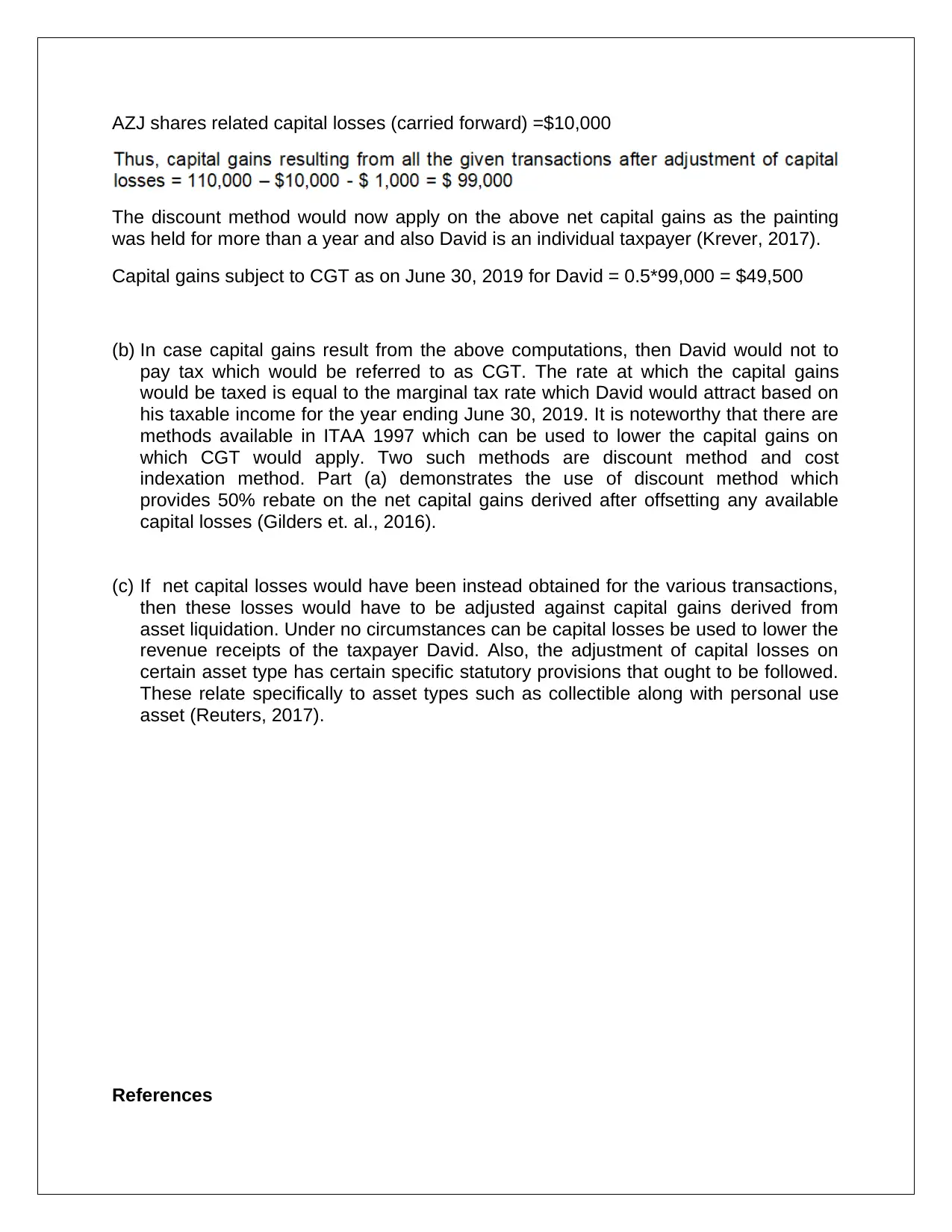
AZJ shares related capital losses (carried forward) =$10,000
The discount method would now apply on the above net capital gains as the painting
was held for more than a year and also David is an individual taxpayer (Krever, 2017).
Capital gains subject to CGT as on June 30, 2019 for David = 0.5*99,000 = $49,500
(b) In case capital gains result from the above computations, then David would not to
pay tax which would be referred to as CGT. The rate at which the capital gains
would be taxed is equal to the marginal tax rate which David would attract based on
his taxable income for the year ending June 30, 2019. It is noteworthy that there are
methods available in ITAA 1997 which can be used to lower the capital gains on
which CGT would apply. Two such methods are discount method and cost
indexation method. Part (a) demonstrates the use of discount method which
provides 50% rebate on the net capital gains derived after offsetting any available
capital losses (Gilders et. al., 2016).
(c) If net capital losses would have been instead obtained for the various transactions,
then these losses would have to be adjusted against capital gains derived from
asset liquidation. Under no circumstances can be capital losses be used to lower the
revenue receipts of the taxpayer David. Also, the adjustment of capital losses on
certain asset type has certain specific statutory provisions that ought to be followed.
These relate specifically to asset types such as collectible along with personal use
asset (Reuters, 2017).
References
The discount method would now apply on the above net capital gains as the painting
was held for more than a year and also David is an individual taxpayer (Krever, 2017).
Capital gains subject to CGT as on June 30, 2019 for David = 0.5*99,000 = $49,500
(b) In case capital gains result from the above computations, then David would not to
pay tax which would be referred to as CGT. The rate at which the capital gains
would be taxed is equal to the marginal tax rate which David would attract based on
his taxable income for the year ending June 30, 2019. It is noteworthy that there are
methods available in ITAA 1997 which can be used to lower the capital gains on
which CGT would apply. Two such methods are discount method and cost
indexation method. Part (a) demonstrates the use of discount method which
provides 50% rebate on the net capital gains derived after offsetting any available
capital losses (Gilders et. al., 2016).
(c) If net capital losses would have been instead obtained for the various transactions,
then these losses would have to be adjusted against capital gains derived from
asset liquidation. Under no circumstances can be capital losses be used to lower the
revenue receipts of the taxpayer David. Also, the adjustment of capital losses on
certain asset type has certain specific statutory provisions that ought to be followed.
These relate specifically to asset types such as collectible along with personal use
asset (Reuters, 2017).
References
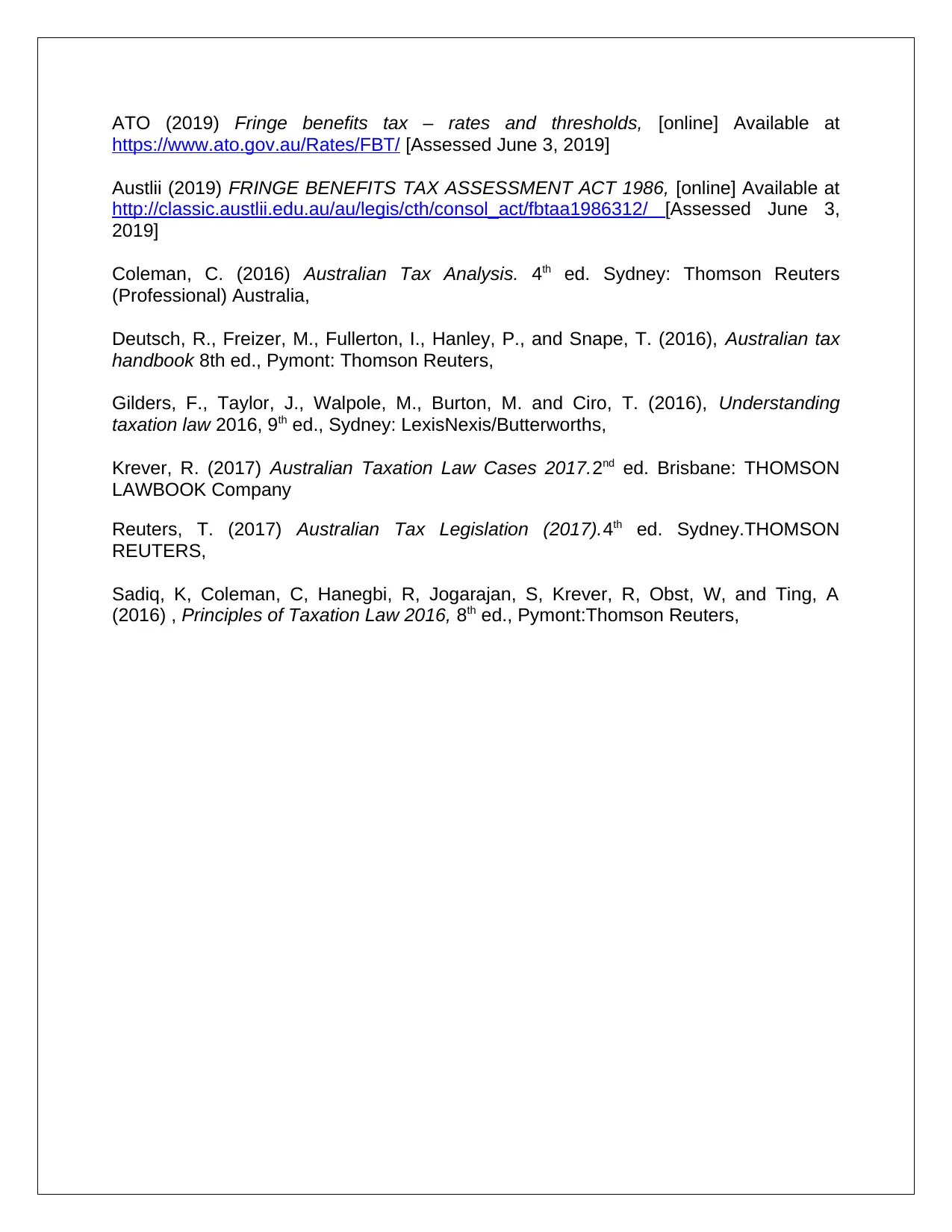
ATO (2019) Fringe benefits tax – rates and thresholds, [online] Available at
https://www.ato.gov.au/Rates/FBT/ [Assessed June 3, 2019]
Austlii (2019) FRINGE BENEFITS TAX ASSESSMENT ACT 1986, [online] Available at
http://classic.austlii.edu.au/au/legis/cth/consol_act/fbtaa1986312/ [Assessed June 3,
2019]
Coleman, C. (2016) Australian Tax Analysis. 4th ed. Sydney: Thomson Reuters
(Professional) Australia,
Deutsch, R., Freizer, M., Fullerton, I., Hanley, P., and Snape, T. (2016), Australian tax
handbook 8th ed., Pymont: Thomson Reuters,
Gilders, F., Taylor, J., Walpole, M., Burton, M. and Ciro, T. (2016), Understanding
taxation law 2016, 9th ed., Sydney: LexisNexis/Butterworths,
Krever, R. (2017) Australian Taxation Law Cases 2017.2nd ed. Brisbane: THOMSON
LAWBOOK Company
Reuters, T. (2017) Australian Tax Legislation (2017).4th ed. Sydney.THOMSON
REUTERS,
Sadiq, K, Coleman, C, Hanegbi, R, Jogarajan, S, Krever, R, Obst, W, and Ting, A
(2016) , Principles of Taxation Law 2016, 8th ed., Pymont:Thomson Reuters,
https://www.ato.gov.au/Rates/FBT/ [Assessed June 3, 2019]
Austlii (2019) FRINGE BENEFITS TAX ASSESSMENT ACT 1986, [online] Available at
http://classic.austlii.edu.au/au/legis/cth/consol_act/fbtaa1986312/ [Assessed June 3,
2019]
Coleman, C. (2016) Australian Tax Analysis. 4th ed. Sydney: Thomson Reuters
(Professional) Australia,
Deutsch, R., Freizer, M., Fullerton, I., Hanley, P., and Snape, T. (2016), Australian tax
handbook 8th ed., Pymont: Thomson Reuters,
Gilders, F., Taylor, J., Walpole, M., Burton, M. and Ciro, T. (2016), Understanding
taxation law 2016, 9th ed., Sydney: LexisNexis/Butterworths,
Krever, R. (2017) Australian Taxation Law Cases 2017.2nd ed. Brisbane: THOMSON
LAWBOOK Company
Reuters, T. (2017) Australian Tax Legislation (2017).4th ed. Sydney.THOMSON
REUTERS,
Sadiq, K, Coleman, C, Hanegbi, R, Jogarajan, S, Krever, R, Obst, W, and Ting, A
(2016) , Principles of Taxation Law 2016, 8th ed., Pymont:Thomson Reuters,
⊘ This is a preview!⊘
Do you want full access?
Subscribe today to unlock all pages.

Trusted by 1+ million students worldwide
1 out of 9